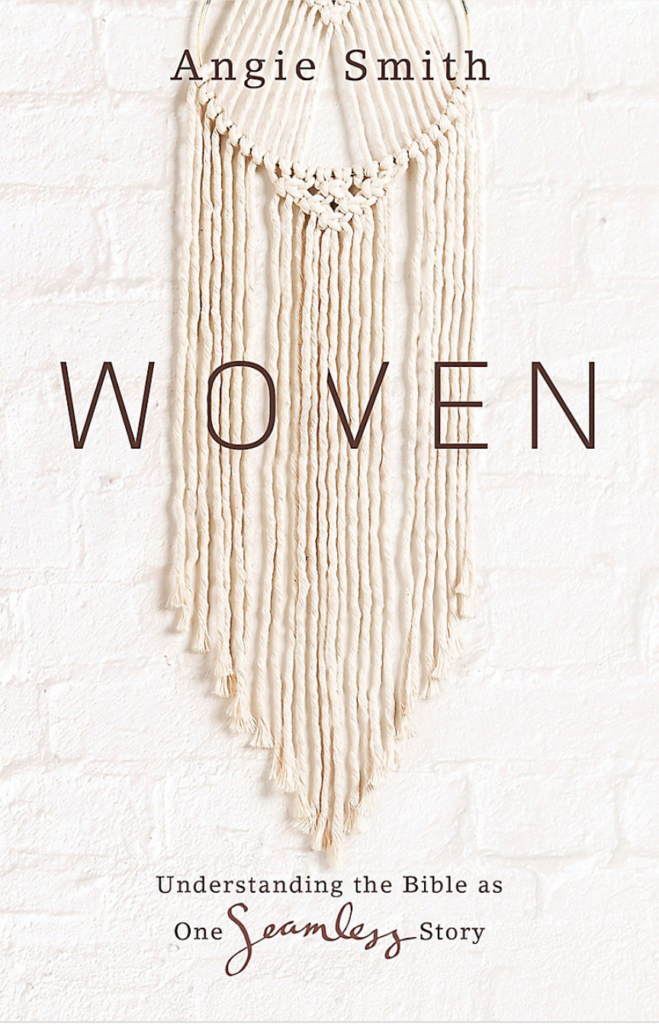Each month, you’ll hear from one of us on what we’re reading and a little bit about the book. This month we’re sharing book notes on Angie Smith’s Woven Enjoy!
I was in the sixth grade when I first opened my Bible outside of a church event. While I grew up going to church and knew about the Egyptian plagues and the adventures of David, I can’t say that I had truly read the Bible with the desire to understand Jesus on a personal level. So, I decided to start at the beginning. I slowly read through Genesis and Exodus and found myself stuck in Leviticus. How was I to make sense of all these rules and genealogies? Who were these people? I quickly flipped to something a little more comfortable— the four gospels I recognized from Sunday school—bypassing the remaining books of the Old Testament.

Angie Smith addresses the frustration we face when first reading the Bible on our own in Woven. A combination of history, prophecy, poetry, narrative and personal letters, the Bible can feel rather intimidating. Not to mention, the sixty-six individual books are not necessarily placed in chronological order. However, “… this Book is actually—drumroll!—the telling of one single story. We will see Jesus woven (yes, intended) throughout every single bit of it. … He shows up in places we never knew to look.”1 Wow. What my sixth-grade self would have given for the CliffNotes® version of the Bible in its entirety to simply grasp the main plot line.
When I found myself camped out in the Book of Leviticus, I could have borrowed a commentary from my dad’s collection on his bookshelf, but that seemed equally as terrifying. Something I greatly appreciate about the book Woven is that Smith’s choice audience is those that have been in her shoes. She writes as a friend, casually walking the reader through each of the individual books that make up the Bible (even including an illustration or two).
She even includes the Old Testament pieces that I skipped over in my younger days. The historical accounts and prophecies show us that the same God who told Abraham that he would have a son in his old age is the same God that told Mary she would give birth as a virgin to the promised Messiah. “God used this particular method of miracle–the birth of a child under divinely charged circumstances–to foreshadow how he would bring his redemptive, covenant plan to completion through the most miraculous birth of all, the birth of Jesus.”2
Readers pause to understand the symbolism of the Passover–an annual Jewish festival that commemorates the last plague of Egypt. The angel of the Lord passed over the homes of the Israelites that had followed his command to paint their doorposts with the blood of a sacrificed lamb. Fast forward several hundred years. We read the last time that Jesus celebrated Passover with his disciples on earth. As “He said to them … ‘I have earnestly desired to eat this Passover with you before I suffer. For I tell you I will not eat it until it is fulfilled in the kingdom of God.’ By his own body. By his own blood. Our Passover Lamb.”3
Whether you are a longtime follower of Jesus or someone just beginning a relationship with Christ, I recommend adding Woven to your list of summer reads. Each of us could use the reminder that our salvation is made possible by the fulfilment of God’s greater plan. He “… continued seeking us as his lost and sinful people, refusing to let our sins be the death of us. Choosing instead to be life for us. That’s the thread. God’s pursuing love.”4
Megan Kyle works as a member of the procurement team alongside Lifeway Women to bring their creative dreams to life. While she spends a majority of her day to day working on the business side of ministry, she loves serving and being the hands and feet of Jesus in the local community. Megan and her husband, Justin, live in Franklin, Tennessee. If you’re ever in the area, you might run into Megan enjoying a latte at a coffee shop or wandering the aisles of a bookstore.
1. Angie Smith, Woven (Nashville: B&H Publishing, 2021).
2. Ibid.
3. Ibid.
4. Ibid.

